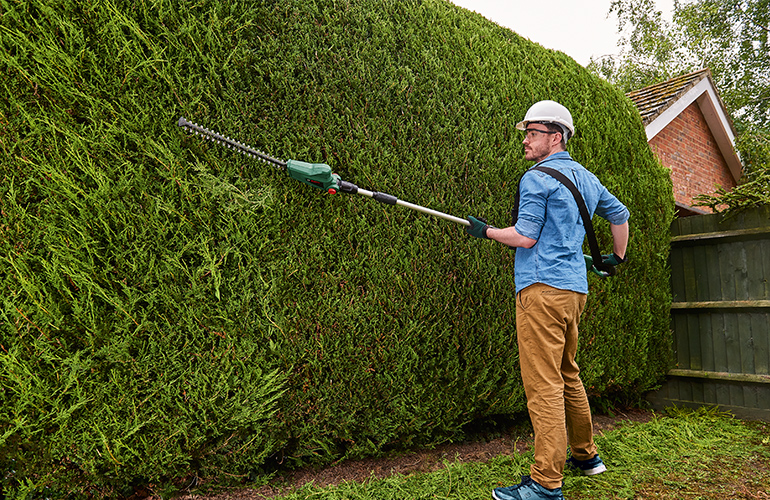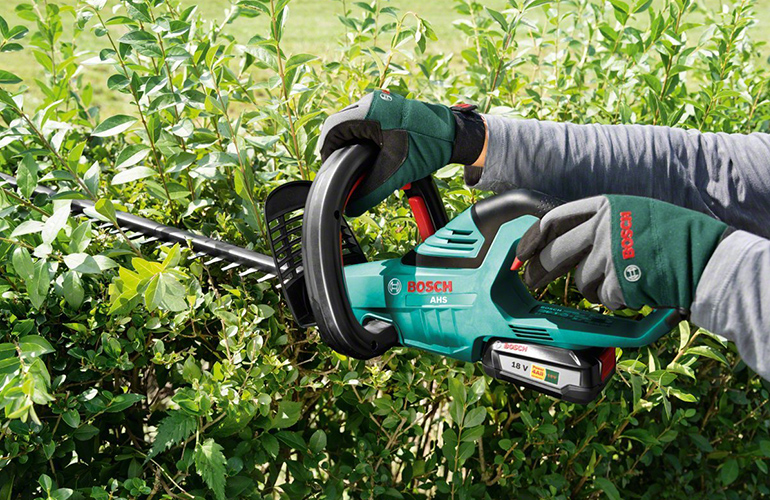
A garden without a hedge is like summer without any sun. Hedges provide a natural fence, giving you privacy against the elements, and giving birds a safe place to hide out between the leaves. Read our guide to learn the basics on how to trim your hedges like a pro.
To help it grow and look good, you need to cut your hedges from time to time. Depending on the condition and age, it may be a question of simple maintenance or shaping, or moderate to radical pruning.
Whatever your aim, it’s easiest with a pair of electric hedgecutters, such as the Bosch AHS 50-20 LI hedge trimmer. For each cutting technique you want to try, you should select the appropriate teeth spacing (the distance between the individual teeth on the cutter blade). For taller hedges up to 2.6 metres, the Bosch UniversalHedgePole 18 is ideal.
Light pruning
You should give non-deciduous (evergreen) hedges a light prune once a year, ideally between May and August. Deciduous hedges should ideally be trimmed twice a year, once in spring and once in late summer/early autumn.
It’s best to wait until the main bud break to do the second trim, when the newly grown buds are fully developed and the hedge isn’t growing quite as much. That way the cut will last a little longer.
Dry, overcast and frost-free days are ideal for trimming work; strong, direct sunlight could damage the shoots.
For contouring and light pruning, a pair of cutters with a small teeth spacing is sufficient because you’re mainly cutting young, thin branches. Otherwise, a powered secateur such as the Bosch EasyPrune allows you to thin out individual branches in hedges with minimal effort.
Ideally, you should trim your hedge in a trapezoid shape, i.e. the bottom branches should be longer than the top ones to ensure that all parts of the hedge get plenty of light. You can clip approx. 10–15 cm of the newly grown shoots straight across. To make sure the hedge isn’t crooked, you can use a piece of string to guide you.
Moderate pruning
For this type of trim, you should make sure that the teeth spacing on your cutters is bigger than the thickness of the branches. It’s best to work on frost-free days and cut back the fruit-bearing branches by as much as two-thirds. By doing so, you can remove the competing shoots, so the branches can again sprout buds effectively.
For hedge plants that stem from trees, such as the field maple or hornbeam, you can prune three-quarters of the shoot tips in the first year. This will help the branches grow more widely/densely and make for a thicker hedge.
Hard pruning
Sometimes, older hedges need more radical pruning to restore their glory days and close over any gaps. Frost-free winter days are perfect for this type of work.
It’s best to use cutters with a large teeth spacing and a powerful motor. Prune back the branches to the thickest trunk and they will grow back more densely in the spring.
My hedge has gaps in it. What should I do?
If your hedge has gaps in it, it may only need a little more sunlight to help close them. Simply trim back the bordering branches that are shading the problem areas.
If a gap is fairly big, try crossing two neighbouring shoots over the hole – horizontally or diagonally – with the help of two bamboo sticks. Then trim the tips of the shoots slightly and see what happens. This should stimulate growth and help the gap to close over.
If the shoots aren’t long enough to do this, the other option is to do more planting.

